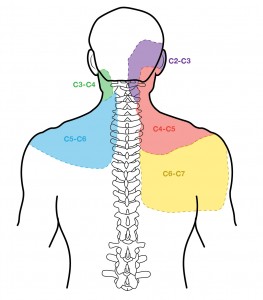
This diagram show the regions of the neck and shoulder girdle that are painful when a facet or zygapophyseal joint (z joint) is perturbed. The exact pathology generating the pain is unknown.
In the late 1990’s, I encountered the work of Professor Nikolai Bogduk, a professor from Australia. Dr. Bogduk pioneered work in the treatment of whiplash. He documented that the majority of chronic whiplash pain, including headache and dizziness, emanated from the cervical spine. He used elegant diagnostic techniques involving the provocation and ablation of pain through fluoroscopic injections to joints in the neck called the zygapophyseal or facet joints. He demonstrated the most common source of headache after whiplash was the C2-3 Z-joint, and the most common source of neck and shoulder pain after whiplash was the C5-6 Z-joint. He also demonstrated some amazing studies that in patients who had psychological problems after whiplash, adequately treating their pain with Z-joint blocks, allowed their psychological problems to resolve. A colleague and I began contemplating this in relationship to concussion.
The symptoms of concussion and whiplash overlap almost entirely. Each has about 22 symptoms and they share 21 of those symptoms. The mechanism of concussion and whiplash is virtually identical in that both are caused by head shake. Given the data from Professor Bogduk, we believe that some of the headache after a concussion could be caused by upper Z-joint dysfunction. I often will examine the C2-3 Z-joint and provoke it with palpation. Patients will often remark that they are experiencing the headache that they have been associating with their concussion. Treatment of the cervical spine can minimize the prolonged recovery associated with concussion. The Schneider Group from Calgary demonstrated in 2014 that in athletes with delayed recovery, treatment of the neck and vestibular system allowed the majority of the treated patients to return to activity and sport. Since that time, the cervical spine has found itself as one of the seven key trajectories of the concussion syndrome. Don’t overlook the cervical spine as a potential source of ongoing symptoms after a concussion. For clinicians, especially those who cover athletic events, always evaluate the cervical spine carefully in individuals who are concussed. An unstable cervical spine injury would be even more serious than a concussion.
